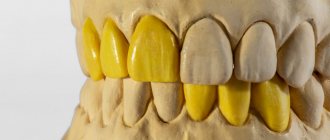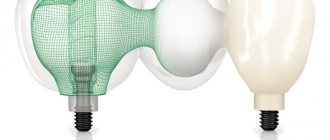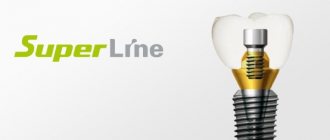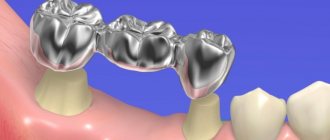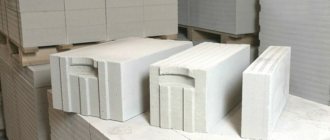04/14/2021 Today it is difficult to imagine restorative dentistry without computer programs. Manual production of dentures by casting is gradually giving way to new, accurate and fast CAD/CAM technology in dentistry.
CAD/CAM is a modern digital technique that automates the process of creating dentures: the workpiece is modeled in an electronic program and milled on a computer numerical control (CNC) machine. The technology is applicable to zirconium, titanium, cobalt-chrome, glass ceramics, etc.
What are CAD and CAM?
- CAD – Computer-Aided Design (from English computer assistance in design and modeling). After scanning the oral cavity, the model is created in virtual space using special software. As a result, the crown fits perfectly.
- CAM – Computer-Aided Manufacturing (from English computer assistance in production). Data about the modeled product is transferred to a CNC machine, where the crown is automatically turned.
With traditional cast crowns, the patient experienced discomfort when making impressions, and situations could arise where the crown did not fit exactly. In addition, the production time of the prosthesis took an average of 2-3 days, during which the patient was left with exposed, ground teeth.
Not only are cad/cam crowns more accurate and superior than their casting sisters, but they are also produced significantly faster—reducing the number of dental visits to just one. At the same time, the patient can personally observe the production of the prosthesis, and it looks impressive.
Benefits of CAD/CAM
- Creation of structures of any shape and complexity.
- No discomfort when scanning the oral cavity.
- Speedy production of orthopedic structures.
- Ability to create products from different metals, including zirconium dioxide.
- High-precision computer technology (accuracy up to 25 microns).
CAD/CAM technology is suitable for creating one-piece ceramic and metal fixed prostheses of various types: crowns, veneers, abutments, etc. This method does not have the usual disadvantages of previous technologies: shrinkage, deformation, overheating of the metal, the presence of pores and unshed areas.
Stages of creating dentures
- Preparation for prosthetics (hygiene, sanitation, preparation of supporting teeth).
- Scanning the oral cavity with an intraoral scanner.
- Electronic three-dimensional modeling of an individual Ked/Kam crown.
- Automatic turning on a milling machine.
- Sintering and grinding.
What cad/cam programs are there?
For full operation of CAD/CAM equipment, correct software is required. The general name for software products that allow three-dimensional modeling and transfer of data to equipment is CAE. CAE – Computer Aided Engineering (from English computer assistance in engineering analysis). Essentially, this system controls the operation of equipment, analyzes and automates numerical calculations.
A separate CAD/CAM program is compatible with open-type design systems in which components (scanner, software, milling machine, consumables, etc.) can be replaced. In closed systems, software modules are already integrated into the database.
Popular Digital Dentistry Software:
- Exocad Dentalcad.
Exocad is a completely open program that is compatible with almost any hardware. It features high processing speed, flexible settings and ease of use. Exocad already offers a wide range of capabilities in its basic version, and additional modules make it a powerful professional tool. - Dental System.
This software is constantly updated and the main modeling tools are improved. Today Dental System allows you to combine equipment, materials and all the achievements of digital dentistry to obtain maximum results.
Planmeca.
Planmeca is the leading visualization software, supporting the widest range of 2D and 3D methods. The open system is compatible with any equipment, convenient and easy to manage.
These are not all CAD/CAM programs available on the market for digital dentistry solutions. Their capabilities are constantly being improved, expanding the scope of use, methods and list of materials. And we can confidently say that with the development of CAD/CAM, a new era in dentistry has begun!
How to select a CAD CAM operator for a dental laboratory?
Many dental technicians, taking a course on virtual modeling at our cad cam academy “Stakhanovets”, ask us how we found technicians who understand this?
And this question is really relevant! After all, many of the first trainees are owners of dental laboratories who understand that it will be difficult to develop a new direction on their own, and that this requires a separate person. And preferably reliable! But here the questions arise: Who should it be? What qualities should this person have? Should I hire one of my own technicians or hire a new one? Is it possible to find an experienced one? We can give you a couple of tips so that all this chaos will settle down a little in your head, and you will understand that all this can be solved! So: who is the best candidate for a CAD/CAM position in a dental laboratory?
Many business team builders believe that the best and most loyal employees are those who are nurtured within the company, and I completely agree with this! We will build on this, especially since it is very difficult to find an experienced CAD/CAM operator.
You can count such specialists on your fingers, and they all work somewhere and are valued. So, most likely, you will have to raise your own! Let's look at what a candidate for this position should be like before we start “raising” him?
1) Of course, the most important thing is that he must be a dental technician by training! This is an important point, and we want to focus your attention on this! The future CAD/CAM operator will perform work where this knowledge is simply necessary. Even if he is given an already modeled wax work, which only needs to be scanned, calculated and sent for milling - in such work there are always points not taken into account in the wax that need to be corrected in the program during virtual modeling, otherwise the result may be defective or incorrectly completed work ! And the question arises: “Will a person without education and without experience as a dental technician be able to adequately correct, add or remove something, without understanding what can be removed and what cannot?”
Don't joke with such things! Otherwise, you will have real problems associated with dissatisfaction of your customers and rework of work. It is also desirable that the future CAD/CAM operator have experience working as a dental technician, and not be hired immediately after college. By the way, many CAD/CAM centers have operators without a dental technician background, and even promote the idea that this is not necessary. But I think that’s why many of us have heard reviews that, they say, CAD/CAM, and until you do it yourself, no one will do it properly for you... Don’t repeat these mistakes, hire a dental technician for this position, at least with a 2-year-old experience in removable and non-removable.
PS By the way, if you are not satisfied with the work of any CAD/CAM center, try to find out whether the CAD/CAM operator who is milling your work has a dental technician education? Ask him a couple of things that the dental technician can definitely answer, and then everything will become clear ;-)__
2) So, we figured out that the candidate must be a dental technician with experience, but what else should you pay attention to? Look for a dental technician who loves everything computer related! This could be an avid computer game player, a person who can easily install Windows or another program... You might think, why is this necessary? According to statistics from our CAD/CAM Academy, and we have already trained a large number of dental technicians from Ukraine and other countries, it is precisely the guys who are interested in computers who are very easy to understand the program for virtual modeling! It's like their element! For them, this is just another “program” that needs to be sorted out. And we would like to add that they usually figure it out very quickly!
Let me give you an example from our practice that happened to us recently. Our administrator Tatyana lost her work laptop with all the information for her work! Well, can you imagine Tanya’s shock and horror? All her work and client data disappeared in an instant! To try to restore the data, the guys called some specialist, but he was able to recover only part of the information, saying that the rest, alas, was lost. And then our Tanya, being in a state of despair and “there is nothing left to lose,” remembers that one of our technicians, who is engaged in casting flexible removable dentures (this is our separate direction), once mentioned that he repairs computers! Surprisingly, even we did not know about these abilities of Roman (that’s his name). As a result, in literally 20 minutes Roman restored absolutely all the lost files on the damaged laptop! The story could have ended there if we had not been “hunting” for such dental technicians! )))))
We know that people like Roman are the best candidates for the position of CAD/CAM operator. Dental technician + let’s call him “computer geek”. It will take the least amount of time to train such a person in the necessary dental programs, and you can quickly get an excellent specialist! A specialist who knows what the design should look like and knows how to implement it using the necessary 3D programs and equipment! Naturally, after we learned from the modest Roman about his abilities, we immediately began to train him at the CAD/CAM center for the position of another (already the 5th) CAD/CAM operator. And you know what? This is surprising, but just 2 days of internship, and Roman is already independently modeling his first works in the Exocad virtual modeling program! To my question: “Well, Roma, is it difficult?” Roma makes round, surprised eyes and answers with a smile: “No, of course! What’s so complicated about it?!” So, friends, your task as the head of a dental laboratory or milling center is to find Romanovs like these. Sometimes they are very secretive and taciturn, and their additional skills do not become obvious immediately, but once you have discovered them, do not miss the chance. Offer him development in a new direction and train him to become a CAD/CAM operator!
3) And the last piece of advice, when it's time to train a candidate, investing money and time into it - make sure that this person is reliable and will not leave you anytime soon, for any reason! If you choose one of your technicians for the role of a CAD/CAM operator, then it is advisable that this is one of the “old-timers”, someone who has established himself as a stable employee. It’s better to either conclude a contract with the rest, or agree on training 50% to 50%, or if there are several people in your laboratory who want this position, then invite them to study on their own and the one with the best results will get the position. In the end, it is their knowledge, and you need to invest money in your knowledge. But this is all at your discretion. Each laboratory decides the issue of employee training individually. Personally, in our center we have created a special fund for training our CAD/CAM operators. The money for this fund comes from courses offered by our CAD/CAM Academy. And to ensure that employees do not leave us, we adhere to 3 rules:
1) Decent salary.
2) Care and respect for employees is no less than for the client.
3) No scandals or psychological suppression!
Try it - it works great 
Let's summarize. The best candidate for a CAD/CAM operator position is a dental technician with experience as well as computer programming skills. And if this is also your time-tested employee, then you are generally lucky and lucky! Of course, if a person does not have computer skills and programs, he can also be trained in a dental virtual modeling program - it will just take more time. The main thing is not to hang your nose and understand that nothing is impossible! Anyone who wants to will learn. Just some earlier, and some later. But if you have the desire, you will definitely succeed!
And if you need help with training, feel free to contact our CAD/CAM Academy “Stakhanovets”. We have not yet met anyone whom we could not train. Good luck to you, colleagues! And we wish that only those people who will always work with you will be a single team, collectively moving towards success and prosperity.
We have not yet met anyone whom we could not train. Good luck to you, colleagues! And we wish that only those people who will always work with you will be a single team, collectively moving towards success and prosperity.
Sincerely, Tatyana Moiseeva – Director of Personnel and Personnel Training, CAD/CAM, Kiev
Author: “Stakhanovets” -
Brief economic calculation of a 3D metal printer for dentistry:
1. The cost of the powder (25-40 microns) is 18,000 rubles. Cost (direct) of manufacturing 1 frame (2g product + 1g support) = 3*18=54 rubles. 2. Production time for 60 units – 2 hours. The number of loads per day is 4. The number of manufactured units per day is 240. 3. When one machine is filled to 60% with LSP (240*22*0.6), the total number of units will be 3168 (taking into account defects and rework). 4. With the cost of laser sintering on the market starting from 300 rubles, the gross profit will be 728,000 rubles. 5. The payback of the technology at 60% load will be less than 10 months.
Advantages of the CAD/CAM system compared to the “classical” production of structures.
The undeniable advantages of the system include:
- High precision in product manufacturing - no shrinkage or deformation of the material, ensuring the highest quality finished product that fully complies with the specified parameters;
- The ability to take into account the needs of any patient - The ability to manufacture objects of any complexity and configuration, including hollow ones;
- Possibility of manufacturing prostheses from zirconium dioxide;
- Minimum production time for dental structures - visualization of intermediate and final results, their agreement with the patient allows you to start the manufacturing process in the shortest possible time;
- Fully automated manufacturing process, eliminating the human factor;
- Compact installation dimensions.
Orthopedic structures manufactured using CAD/CAM technology
CAD/CAM technology makes it possible to produce removable and fixed models of prostheses, as well as products of other types, in particular, surgical templates. However, despite the presented functionality, CAD/CAM is most widely used to create permanent orthopedic models:
- veneers;
- tabs;
- crowns made of solid ceramics and zirconium;
- bridge structures;
- telescopic crowns;
- temporary crowns that require production in the shortest possible time.
- individual abutments for implantation.
Advantages and disadvantages of the system
Any technology for manufacturing dentures has both its pros and cons. The CAD/CAM system in dentistry is no exception, although, of course, it has more positive aspects.
Advantages of prostheses made using this technology:
- They have exceptional accuracy. The usual technique involves taking impressions by a prosthodontist, casting a jaw model from plaster by a dental technician, hand-making the frame and coating it with ceramics. During all these stages, minor errors inevitably occur (independent of the qualifications of specialists), which together lead to inaccuracy of the finished prosthesis and possible discomfort when wearing it. The CAD/CAM system reduces to zero the likelihood of error and inconvenience of the future design.
- They do not cause discomfort, do not rub the gums, and do not cause pain. They are characterized by high strength and durability, as the exceptional strength does not cause premature overload of the prosthesis and reduces the likelihood of breakage.
- The manufacturing time of a structure using computer technology is significantly less than using the classical method. On average, the patient receives a finished design in a few hours, while the usual process of creating dentures, using impressions and the work of a dental technician, lasts about 5-7 days. Therefore, the CAD/CAM system is indispensable in emergency cases when it is necessary to urgently restore the dentition (for example, before an important event).
- The patient can see his future prosthesis on the computer screen in advance, if necessary, discuss possible options with the dentist and adjust the final result. This significantly increases the aesthetic satisfaction of both the patient from the prosthesis received and the doctor from the quality work done.
- CAD/CAM technology in dentistry allows us to help people even with the most difficult clinical cases. For example, the need to prepare a large number of teeth in case of malocclusion makes it difficult to manufacture a prosthesis according to the classical version, since there is a high probability of a strong error. But computer scanning will allow you to accurately calculate the angle of inclination of each tooth and program the ideal design for each case.
- CAD/CAM technologies make it possible to produce a prosthesis from any type of material - alloys of cobalt and chromium, zirconium dioxide, ceramics, composite material. The computer has several programs to work with each of these substances to produce a highly aesthetic final product.
The only significant disadvantage of prostheses made using the CAD/CAM system is their high cost. The use of computer equipment for prosthetics increases the price by an average of 2.5–3 times.
Control systems programming training program:
| MODULE 1. G and M codes |
| Basics of programming CNC machines. |
| Basic G and M codes. CIMCO Edit |
| MODULE 2. CAD |
| Familiarization with the menu of CAD programs. |
| Sketch construction |
| Construction of body parts |
| Construction of rotation parts |
| MODULE 4. CAM |
| Familiarization with the CAM program menu |
| Importing parts into CAM. Creating a blank primitive. |
| Setting the workpiece to “0” |
| Creating a turning/milling operation. Exploring the Processing Operations Menu |
SUBMIT YOUR APPLICATION
What is the technology
The main advantage of the CAD/CAM system in dentistry is that the types of prostheses produced are highly accurate compared to conventional prosthetics. The use of a computer also ensures the speed of production and high convenience of the product for the patient.
This technique requires the following tools:
- intraoral camera;
- directly the computer;
- milling machine.
After selecting the required elements, you can proceed to creating prostheses, which includes several stages:
- An orthopedic dentist prepares teeth for prosthetics. Using a drill, he grinds off some of the enamel and dentin from the tooth - this is necessary to create space for the future prosthesis. This stage is no different from conventional orthopedic preparation.
- The doctor takes a virtual impression of the patient’s teeth using an intraoral camera. Its use has a huge advantage for prosthetics for people with an increased gag reflex, for whom taking conventional impressions with impression material on trays is a difficult and sometimes insoluble test.
- At the end of the appointment, the prepared teeth are covered with protective varnish or artificial crowns. This is done to prevent pain and increased sensitivity.
Taking an impression
The further process of creating a prosthesis occurs without the participation of the patient and is carried out on a computer or laptop on which the CAD/CAM program is installed:
- Information from the intraoral camera is transferred to computer media.
- Using a special program, the doctor creates a virtual three-dimensional sketch of the future prosthesis. The patient’s teeth, located symmetrically on the other side of the jaw, serve as a standard for the simulated teeth. If there are none, the program itself selects the optimal result. The advantage is that you can select several different options (shape, inclination of teeth), adjust and discuss them with the patient. The duration of this stage can vary from several minutes to 1-2 hours, depending on the complexity of the initial situation.
- After determining the final version, its 3D sketch is saved. The information is sent to the milling machine on which the frame is manufactured. The material can be cobalt-chromium alloy or zirconium dioxide. The metal block is processed with special cutters in the sequence specified by the computer, and the frame of the future prosthesis is obtained. Then it is ground and polished. The turning process lasts approximately 10-15 minutes.
- To increase the aesthetic effect, the metal part is coated with ceramic mass in a special oven.
- The finished prosthesis is transferred to the dental office and tried on by the patient. After fitting, the artificial teeth are fixed to the jaw.






